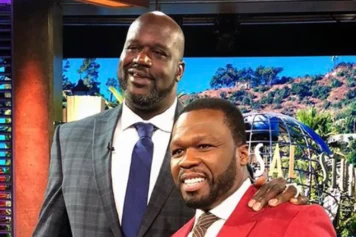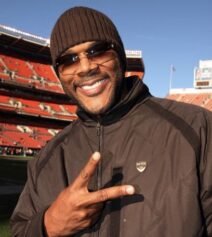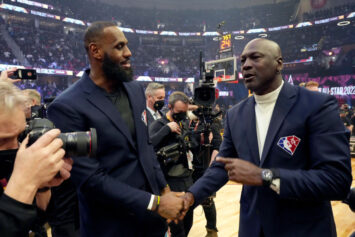Like many people around the country today, I’m beyond hyped for BET’s New Edition biopic mini-series, the first of three parts which airs tonight at 9:00PM EST.
One of the greatest groups in the history of music, regardless of genre, these cats from the Boston housing projects never got the recognition they deserved as being on par with the Jackson 5 and setting the stage for every significant boy band, from the New Kids on the Block, Boyz II Men, Hi-Five, the Backstreet Boys, N’Sync, One Direction, and anyone else that you want to name that has since followed in their footsteps.
One of our music and entertainment contributors, Ericka Blount Danois, wrote a fantastic piece for The Root in advance of the premiere.
“In one of the most poignant scenes in the BET miniseries The New Edition Story, the young Ronnie DeVoe, Bobby Brown, Ricky Bell, Michael Bivins and Ralph Tresvant are fresh off their first major world tour,” Ericka writes. “The tour bus, painted with the groups name in graffiti letters on the side, pulls in slowly to drop the singers off at the Orchard Park projects in Bostons Roxbury neighborhood, where they grew up.
Despite all their hard work and newfound fame, the budding stars havent earned enough money to move out of the hood because of a shady record deal, which included an advance of $500 and a Betamax video player. Their mothers are all still on food stamps, and the boys royalty check is a whopping $1.87, even with a No. 1 record on the charts and after repeatedly selling out New York Citys Madison Square Garden.
It wasnt just a regular Betamax. It was one of those that you could connect a VHS to, says Bell, joking about it now on the phone as DeVoe and Brooke Payne, the groups choreographer (and DeVoes uncle), laugh. But the guys all remember they were in tears and embarrassed at the time.
It was tough. It was humbling to go back home, Bell says. Your friends had seen you on TV. And were still going back to the same schools. Were thinking we made it big, but were right back there.”
Like so many others, I grew up with New Edition, not in the literal sense, but figuratively. I always tell people that the two greatest gifts my mother ever gave me was a subscription to sports Illustrated when I was in the third grade, and two turntables and a mixer when I was 12.
By that time, I’d already acquired a sizable vinyl collection. My buddies and I would hang out in my Brooklyn apartment bedroom for hours as we talked about and debated sports while I hovered over the DJ equipment, mixing up Michael Jackson, Rick James, Prince, Patrice Rushen, The Jones Girls, the S.O.S. Band, James Brown, Shalamar, Prince, Evelyn Champagne King, Stevie Wonder, D Train, Debarge, Gwen Guthrie, George Benson, Junior, Howard Johnson, Ren and Angela, Planet Patrol, The Gap Band, Earth Wind and Fire, Steve Arrington, Esther Williams, Alicia Myers, Grandmaster Flash and the Furious Five, the Sugarhill Gang, Dr. Jeckyll and Mr. Hyde, Herbie Hancock, Grandmaster Melle Mel, Malcolm McLaren, Run-DMC and so many others.
And then New Edition dropped the Candy Girl album, and we were hooked. I’d often stare at the album cover and back, thinking about these kids from Boston who were my same age. When going through heartache over the girls I had crushes on, I’d play Jealous Girl and Is This The End ad nauseam. When the mood was fun, it was Popcorn Love and Candy Girl on a continuous loop.
In the summer of 1984, as I was packing my bags to head off to a New England prep school, my most prized possession was my newly acquired album, the group’s second offering which was eponymously titled, New Edition. It proved to be my wealthy roommates’ introduction to R&B, as I blasted Lost in Love, Mr. Telephone Man, Cool it Now, and I’m Leaving You Again non-stop.
From the departure of Bobby Brown and the addition of Johnny Gill, on through their individual solo projects and the birth of Bell Biv Devoe, the reunions, the brief stint with Puffy at Bad Boy, the underappreciated Heads of State spinoff with Brown, Gill and Ralph Tresvant and everything in between, I’ve been right along with them for the ride.
The most amazing, life-altering experiences I’ve ever had at a live concert in my life were courtesy of Prince, Stevie Wonder, Earth Wind and Fire and New Edition.
Right now, I’m trying to hurry up and finish my work, because I can’t wait to get to tonight’s viewing party of the BET original film, which will be the first of a three-night affair. The anticipation level, for me, is even greater than waiting to watch the Super Bowl. I’m anxiously looking forward to the behind the scenes stories of one of my favorite groups, and reminiscing on my life from 1982 on through today and how the soundtrack of their music lies beneath many of my most fond experiences.
One of the things that endeared the group to us as kids, in addition to the dope music, was their love for our other passion, basketball.
Throughout his journey from that cool kid with a basketball handle in the Orchard Park Projects in the rugged Roxbury section of Boston to formulating the groundbreaking R&B group, which has been commercially and culturally relevant in the recording business for close to four decades and counting, New Edition’s Michael Lamont Bivins has always maintained his passion for success.
The flavor of our beautiful game saturates his classic music video frames: playing ball in Cool It Now, taking cats off the dribble in Bell Biv DeVoes Poison joint, and rocking the orange Sherman Douglas Syracuse #20 piece in BBDs Do Me, among others.
His seamless transition game from the playgrounds of Boston to recording artist to managing and producing Boyz II Men made history when they achieved #1 status on Billboards Top 100 for 13 weeks with the 1992 song End of the Road, breaking a record that Elvis Presley held for 36 years. With Boyz II Mens $60 million in record sales, to go along with his BBD and New Edition certified platinum status, Mikes head is far from gassed.
Though he is an official triple-threat as a baller, singer and producer with the numbers and the hood credibility to back it up, Bivs precedent setting imprint on playground style and its translation into the mainstream remains understated, yet powerful.
Orchard Parks finest sat down for a wide-ranging conversation with me a few years back, exploring the foundation of his essence – the hoops culture that nourished his dreams and took his life trajectory from project kid to renaissance man. I’m dusting off some of that conversation for your enjoyment, and giving you the inside scoop on how the game of basketball was responsible for the formation of one of the greatest groups ever in the history of music.
***
How important was playing ball on the playground to you as a kid growing up in the Orchard Park projects?
When we were young, we couldnt get on the court because the older kids stayed out there, so we had to resort to playing on the crates. Between buildings it seemed as long as a football field, but wed run full court, from one crate to another. When people would get off their bus coming home from school, youd see a bunch of jackets and bags dropped on the ground, no matter how cold it was. Thats what we had to do, play ball, before we went in the crib.
So when were you able to get some burn with the older kids?
When I was about eight years old, I started playing with the 13-and-under kids. I didnt get any run, but I was hyped to be a part of the team, to be in the layup line, or to get in the game with 30 seconds left if we were up big. I guess the coaches saw something in my dribble to think I was cool enough to get a jersey. And I cherished my uniform.
What were some of the parks you guys would go to, other than the court you played at in Orchard Park?
Well, let me give you the origin of basketball in Orchard Park. One side of the projects never had a basketball court. The side closest to Adams Street, that we called The Other Side, they had a court in the middle of the park which was near Dearborn Middle School. Our side of the projects was split in half, what we called Up from the Speed Bump and Down from the Speed Bump. We didnt have a court on my side. We were like, Weve got all this space, and we aint got no court! So, we went over to Madison Park High School, when it was first built, and stole their rims and backboards.
How did yall do that?
We unscrewed them and about 20 of us walked all the way back to Orchard Park with them. It was crazy! Some of the older guys took these long, skinny poles and got some cement from the Boston Housing Authority. We dug our own holes, cemented them and put the Madison park backboards up. Then we got some spray paint and painted The Trailblazers right in the middle of the court. And that was our spot. We made our own court in the projects.
So were the guys who lived on the other side envious?
The cats that lived on the other side of the speed bump, they did the same thing with the space in between their buildings. So, wed walk 20 yards, play against a different set of buildings and call that an away game. Then, theyd walk 20 yards over to our buildings and that would be their away game. When people would walk through the projects to catch their bus at Dudley Station, it would look like there was this league going on, but it was just some kids, from building to building, playing against each other.
So, did the word get out and other teams start showing up to get down?
We started inviting other teams from Mount Pleasant, Forest Street, Copeland and some other places. Before you knew it, word was spreading around the city. It was project against project, street against street. And the games became scheduled. It was better than any league in the city because both sides of the court were crowded with your people from your hood. We had the table, the clock, the officials, and it was streetball at its finest.
In the earliest New Edition videos, it was apparent that ball was a big part of your lives.
We all played ball at the Orchard Park Rec Center growing up. Wed all met in the gym, around basketball, and it was important that we showed that part of ourselves in the videos because thats who we really were. So when we got in the music business, it was as much a part of us as singing was. When we werent on stage, we were playing ball.

So is it safe to say that the game gave birth to the incredible phenomenon that became New Edition?
In essence, the synergy of the recreation center was responsible for New Edition, and basketball was a huge part of that. Before the national AAU scene blew up, the Boston Shootout was legendary in the 70s and 80s, where all the top players from around the country came to play and represent their cities.
Were you at those games?
A guy named Claude Pritchard saw me and a couple of other kids playing on the courts in Orchard Park and said we needed to come down to the Boys Club. It was about ten minutes from the projects, but we never considered spending money for a membership when we could play outside for free. He bought us our first membership, and it just so happened that the Roxbury Boys Club was a sponsor of the Boston Shootout. At 9 and 10 years old, I had a game that stood out, so that led to me meeting the Director and other influential people that came in the gym, which led to them making me a ball boy at the Boston Shootout.
So that was your first job?
Yeah, that was my first little job, but I wasnt the lower tier ball boy, I was in charge of the other ball boys.
So youve been running things, on the leadership tip, from day one. What are your favorite memories of the Shootout?
My third year, they did something very special and let some youth teams play a game at halftime of the championship game. It was two eight-minute quarters, running time. Yo! I was 11 years old, playing at Boston University, at halftime of the Boston Shootout championship game, and I got MVP. That was big! Then I changed up and went back to work as a ball boy on the bench.
So when you were a ball boy as a kid, who were some of the players that made you say, Oh Snap!?
I remember when Doc Rivers played for the Chicago team, and they had Windy City” across their jerseys. He could fly like a bird and was a guard that was dunking on everybody. That was one exciting team. I remember Pearl Washington playing for the New York team, before he played at Syracuse. I remember Patrick Ewing playing for Boston. Those teams looked like pro teams in high school. Yeah man, I remember all of that, and how much anticipation there was in the city for that tournament.
What were some of the lessons you learned playing ball that remain embedded in your business philosophy today?
Man, thats a great question. When Im on the court, I want the ball. I want to call the play and be creative enough to make something happen. I was an inclusive player that included everybody. I might not have had the best jump shot, but I could dribble my tail off and get you the ball. So, in music and with my group, I take the same attitude and vision, like Give me the ball and let me make the deal.
You guys are a collection of separate individuals with unique talents and a phenomenal combo when all the pieces coalesce: a musical and entertainment force that resonates across generations. If you could compare New Edition to any basketball team, who would it be and why?
It would have to be the University of Michigans Fab Five, because were the most exciting conglomeration of talent that never got our just do: Grammys, lifetime achievement awards, etc. But we were a force who brought about a lot of musical and stylistic trends that endure to this day.
***
Without a doubt Biv, and hopefully this BET biopic mini-series changes all of that. Make sure you don’t miss The New Edition Story. From all that I’ve heard from people involved in the project and from those who’ve gotten a sneak peak, it’s a phenomenal piece of work that, just like New Edition, will endure because of its unique style, inimitable flavor and incredible substance.



